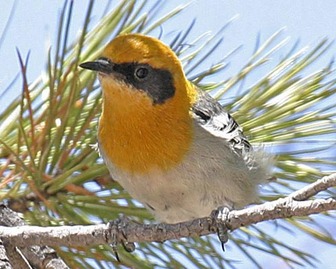Olive warbler
This species breeds from southern Arizona and New Mexico, USA, south through Mexico to Nicaragua. It is the only bird family endemic to North America . It was in the past classed with the Parulidae , but DNA studies suggest that it split early from the other related passerines, prior to the differentiation of the entire New World warbler/American sparrow/Icterid group. It is therefore now given a family of its own.

Original source: originally posted to Flickr as IMG_5633 Olive Warbler (Peucedramus taeniatus)
Author: Tony MorrisPermission(Reusing this file)This image, which was originally posted to Flickr.com, was uploaded to Commons using Flickr upload bot on 23:55, 5 April 2009 (UTC) by Rufous-crowned Sparrow (talk). On that date it was licensed under the license below.This file is licensed under the Creative Commons Attribution 2.0 Generic license.You are free:to share – to copy, distribute and transmit the work
The Olive warbler is classified as Least Concern. Does not qualify for a more at risk category. Widespread and abundant taxa are included in this category.
southwestern New Mexico, the heart of Olive Warblers' range is in the mountains of western Mexico, where they are found in high-elevation pine forests. These birds are active high in the canopy of pines, making them difficult to study. As a result, much remains to be learned about Olive Warblers, including their relationship to other birds. Although long treated as a member of the New World wood-warbler family, this species is now placed in its own family. More
Although the Olive Warbler has long been associated with the New World wood-warblers (Emberizidae: Parulinae), evidence from anatomical and DNA studies has recently placed it in its own monotypic family, Peucedramidae. Superficially, this species seems a typical warbler; in fact, it has often been placed in the genus Dendroica. Further study of its behavior and breeding biology should improve our understanding of its proper taxonomy. More
The Olive Warbler, Peucedramus taeniatus , is a small passerine bird. It is the only member of the genus Peucedramus and the family Peucedramidae. This species breeds from southern Arizona and New Mexico, USA, south through Mexico to Nicaragua. It is the only bird family endemic to North America (including Central America). More
Olive Warbler: Breeds in central and southeastern Arizona and southwestern New Mexico; spends winters mainly south of the U.S.-Mexico border. Breeding and Nesting Olive Warbler: Three to four pale gray or blue eggs with gray, olive, and brown markings are laid in a cup nest made of stems, rootlets, and plant material, lined with rootlets and plant down, and built on a tree branch 30 to 65 feet above the ground. More
Olive Warbler: Breeds in central and southeastern Arizona and southwestern New Mexico; spends winters mainly south of the U.S.-Mexico border. Listen to Call Voice Text "peeta-peeta-peeta", "peu" Interesting Facts * Although the Olive Warbler has long been associated with the New World wood-warblers, evidence from anatomical and DNA studies has recently placed it in its own family, Peucedramidae. More
The Olive Warbler was originally placed in the New World warbler (family Parulidae) genus Dendroica, a group which it closely resembles, particularly in having nine primaries and similar skin. In spite of being assigned to its own genus in 1875, its affinities were a source of contention. The shape of the basihyal bone in the skull, and aspects of its behaviour led to the suggestion that it was instead an Old World warbler in the family Sylviidae. More
Photo Wanted The Olive Warbler, Peucedramus taeniatus , is a small passerine bird, the only member of the family Peucedramidae. This species breeds from Arizona, USA, south through Mexico to Nicaragua. It is the only bird family endemic to North America (including Central America). It was in the past classed with the Parulidae (New World warblers), but DNA studies suggest that it split early from the other related passerines, prior to the differentiation of the entire New World warbler / American sparrow / Icterid group. More
The Olive Warbler (Peucedramus taeniatus) is generally considered to be a "warbler" but it is placed in its own family, Peucedramidae. It is a breeding bird of high elevation conifer forests of parts of the southwest U.S. and Mexico. Within the U.S., the species is generally confined to Arizona and New Mexico, but there are a number of records in the mountains of far west Texas as well. The 5 shots of a male and one shot of a female on this page were taken on Mt. More
If your first Olive Warbler, Peucedramus taeniatus, was an adult male, you probably felt equal parts delight and confusiondelight at the bird’s beauty, confusion over why a orange, black, and gray bird would be labeled “olive.” But this is a sexually dimorphic (male and female have different plumages) species. More
Olive Warbler is a coniferous forest species of highland Mexico and Central America. At the northern limit of its distribution in southern New Mexico, it requires open stands of mature pine and mixed conifer forest. More
Olive Warbler, north of Silver City, July 25, 2003... More
Olive Warbler have been uncertain because its hyoid apparatus (muscles controlling the tongue) is typical of wood-warblers. While it looks like a wood-warbler, it differs in many ways. Some have thought that it is a sylviid. More

Original source: Tony Morris
Author: Tony Morris
Permission: Some rights reserved
Family : Peucedramidae
Genus : Peucedramus
Species : taeniatus
Authority : (Du Bus De Gisignies, 1847)
